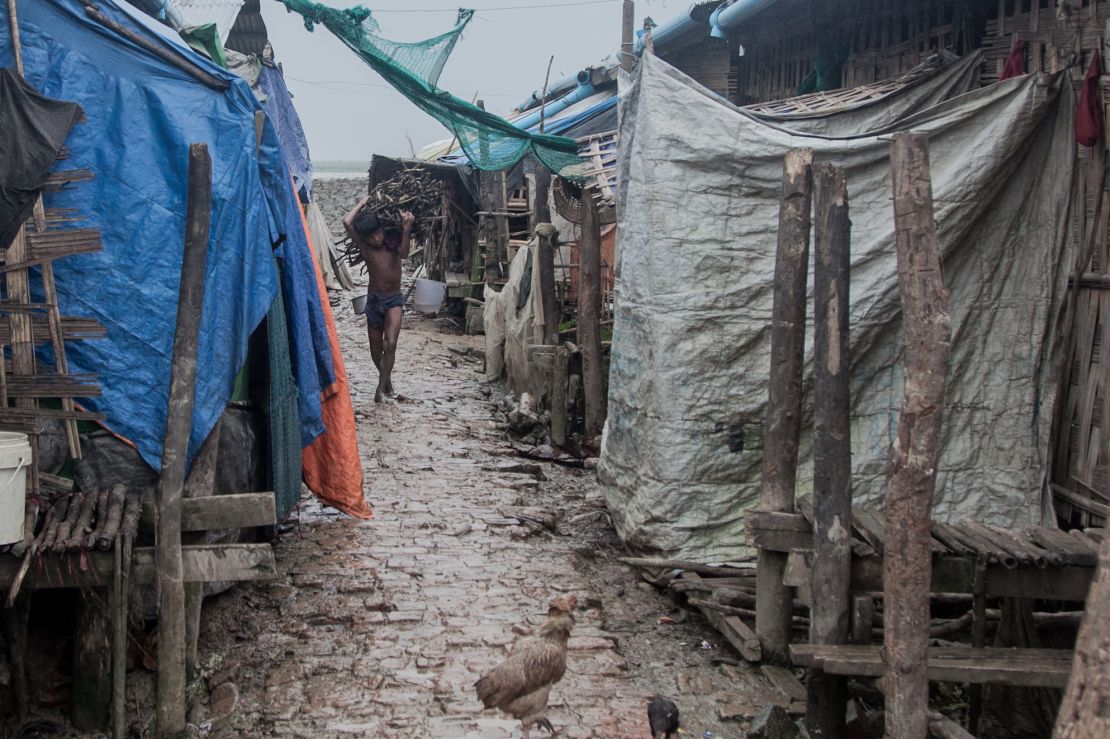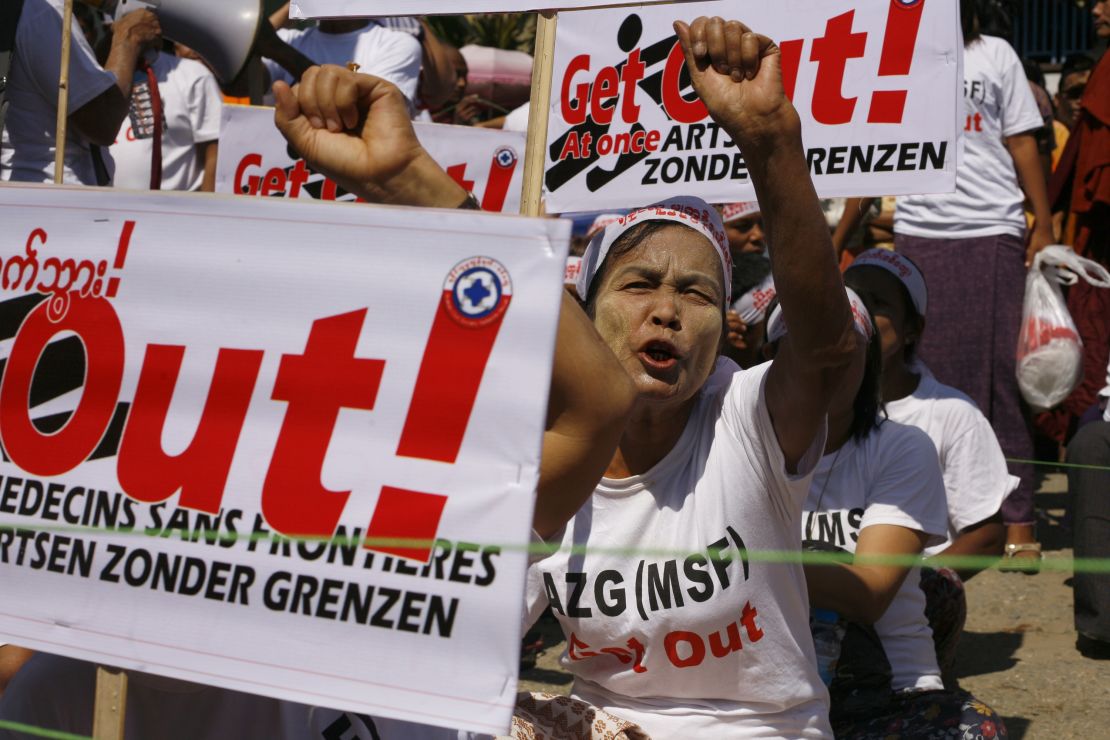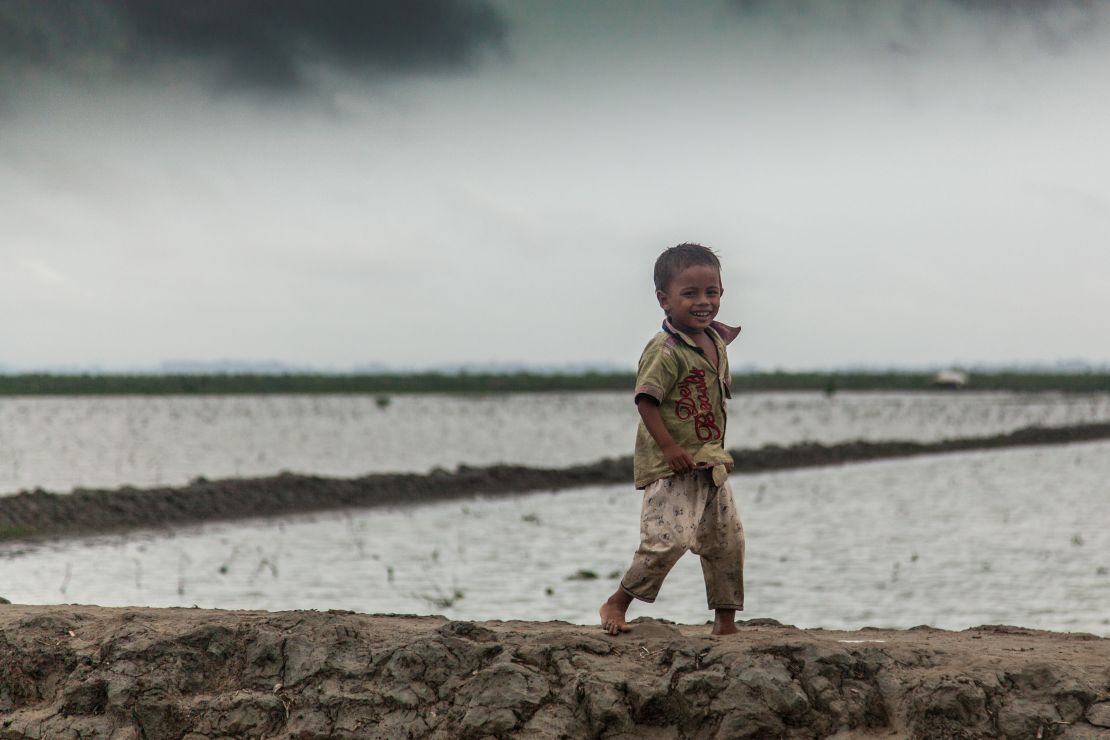Story highlights
140,000 people, mostly Muslims, are confined to camps in Myanmar's Rakhine state
Displaced by outbreaks of violence two years ago, they endure wretched conditions
Marginalization of the Rohingya, who are de facto stateless, drives many to flee via boat
Myanmar has proposed a plan to grant citizenship to some, but rights groups see problems
Nget Chaung, a camp for displaced people on a marginal smudge of low-lying coastland in western Myanmar, is not a place anyone would want to call home.
“No-one should have to live in the conditions that we see in Nget Chaung,” said Pierre Peron, spokesman for the UN Office for the Coordination of Humanitarian Affairs in Myanmar.
Those conditions, said a humanitarian worker familiar with the camp, “are really the worst.”
“The location is flooded much of the time. You have to go through the dirty water to reach your own shelter,” said the aid worker, who asked not to be named due to local sensitivities around humanitarian teams operating in the state.
The shelters, many of which were built to last six months but have now been occupied for two years, are “in very bad condition,” she said. “There’s no livelihood, no opportunity at all.”
Nonetheless, this desperate patch of coastal plain is home to some 6,000 Rohingya Muslims, thousands of them children. Most have been in the camp, subsisting in wretched conditions, since their villages were destroyed in a frenzy of mob violence two years ago.
Trapped in ‘internment camps’
Across Rakhine state, an impoverished region of some 3.2 million in Myanmar’s remote west, more than 130,000 other displaced people are trapped in 67 similar camps. The majority of them are de facto stateless Muslims, living under apartheid-like conditions; most have been there since October 2012, following waves of intercommunal violence that left hundreds dead.
With the camps under guard, and inhabitants forbidden to leave of their own volition – Minister of Information Ye Htut told CNN they were only allowed to leave under police escort, “to prevent further clashes and (ensure) their safety” – the settlements “have essentially become internment camps” for about 140,000 people, according to a recent report by the International Crisis Group.
Wai Wai Nu, a Rohingya Muslim activist, has no hesitation in labeling them concentration camps. “The people there are stripped of their human rights, left with no physical, mental or food security,” she said. “They are depressed, in pain, hopeless.”

The U.N.’s Special Rapporteur on human rights in Myanmar, Yanghee Lee, has noted “disturbing reports of deaths in camps owing to lack of access to emergency medical assistance and owing to preventable, chronic or pregnancy-related conditions.”
When those outside the camps, but confined to their isolated villages by security forces, are counted, the number of Muslims in the state subject to restrictions on movement totals in the hundreds of thousands. It’s a situation which “severely compromises their basic rights to food, health, education and livelihoods,” said Peron.
“Without freedom of movement, people simply cannot rebuild their lives, and continue to rely on international humanitarian aid.”
‘Suffering I have never seen before’
After the U.N.’s Assistant Secretary-General for Humanitarian Affairs, Kyung-wha Kang, visited Rakhine’s camps, including Nget Chaung, in June, she described witnessing “a level of human suffering in IDP camps that I have personally never seen before.”
The situation in Nget Chaung has scarcely improved since Kang’s visit, said the humanitarian worker familiar with the camp.
While residents confined to other camps can often find limited ways to access surrounding markets to eke out a livelihood, Nget Chaung was rare in that its inhabitants were totally isolated, she said. The camp was only accessible by boat, taking between 1.5 to four hours to reach depending on tides, and particularly exposed to severe storms, which occasionally forced the residents to be evacuated.
It was difficult to get contractors in to improve conditions in the camp, she said, as they had been warned off working there by local communities opposed to the Rohingya presence.
Flooding meant medical clinics could only operate at the entrance to Nget Chaung, putting treatment beyond the reach of those too ill to scramble up the camp’s muddy embankments. Skin diseases and gastrointestinal complaints were commonplace. Amidst all this, residents were tormented by the sight of their old villages, within view of their new, prison-like home.
“People have been here two years and they have nothing. Nothing,” said the humanitarian worker. “The desperation is extremely high and it’s increasing.”
How did it come to this?
The crisis in Rakhine state began in May 2012, when the rape and murder of a Buddhist woman by Muslim men ignited long-standing tensions between the Rakhine majority, a Buddhist ethnic group that accounts for about 60% of the state’s population, and the sizable and disenfranchised Muslim minority of about one million, many of whom identify as Rohingya.
The waves of violence that followed – pogroms in June, followed by more organized violence in October – amounted to crimes against humanity and ethnic cleansing of the Rohingya by the Rakhines, according to a Human Rights Watch report. The report alleged the collusion of officials, community leaders, Buddhist monks and state security forces, to terrorize and “forcibly relocate” the Rohingya.
In the aftermath of the violence, Myanmar President Thein Sein reportedly told a visiting United Nations delegation that the government did not recognize the Rohingya as citizens of Myanmar, and was planning to install them in refugee camps until another country could be found to take them.
Despite most having lived in Myanmar for generations, the Rohingya are widely viewed as illegal interlopers from neighboring Bangladesh, and are not listed among the 135 officially recognized indigenous ethnicities of Myanmar. A citizenship law introduced in 1982 led many Muslims to be essentially stripped of citizenship retroactively.
In the years since the Rohingya were driven into the camps, their situation has only become more desperate.
In February, the largest provider of humanitarian medical aid in the state, Medecins Sans Frontieres (MSF, or Doctors Without Borders) was driven out by authorities amid allegations from ethnic Rakhine groups of bias towards the Rohingya.
A month later, a Rakhine mob attacked international aid agencies in the state capital, Sittwe, causing 300 humanitarian workers to flee, $1 million in losses and halting aid for a month. Services have not been restored to capacity, according to the U.N.’s Special Rapporteur on Myanmar – a memorandum of understanding paving the way for MSF to resume operations was not even signed until September, due to opposition from the Rakhine community.
Yanghee Lee noted in a report tabled overnight before the U.N. General Assembly that the Rohingya face “systematic discrimination” and have reportedly been subject to human rights violations including “summary executions, enforced disappearances, torture, forced labor and forced displacements, as well as rape and other forms of sexual violence.” She called on the allegations to be investigated and the perpetrators held to account.
Recent moves at a national level – such as a push by monk-led extremist Buddhist groups for a ban on interfaith marriages – have helped further push Muslims to the social margins.
State-sanctioned marginalization
Under pressure from the international community to curb abuses against the Rohingya, the government is now preparing to announce its solution to the crisis in Rakhine. But a draft of the plan, obtained by CNN, is causing alarm among humanitarian groups.
They fear it only consolidates the state-sanctioned marginalization that has been occurring, and lays the framework for a push to drive the Rohingya out of the country, or leave them permanently interned in camps.
“They’re trying to squeeze, squeeze, squeeze the Rohingya so they have no choice but to leave,” said Chris Lewa, director of the nonprofit advocacy group Arakan Project, which has been advocating on behalf of the Rohingya for more than a decade.
She describes the government’s “action plan” for the Rohingya as part of a “concerted campaign to demoralize, disenfranchise and entice them to leave the country.”
David Mathieson, a senior researcher at Human Rights Watch, agrees. He said that while the plan would legitimately allow the government to remove genuine illegal immigrants from Bangladesh, it appeared designed “to force the Rohingya to get out of there,” he said.
“The Rakhine extremists just want the Rohingya pushed out.”

More than a million people, he said, are “caught between a hammer and an anvil.”
If the goal is to drive the Rohingya out, then it appears to be working, said Lewa. Her organization records the exodus of Rohingya fleeing Myanmar illegally by boat, through networks of people smugglers, through Thailand to destinations like Malaysia and Indonesia.
Her teams of monitors at a dozen departure points along the coast have counted about 10,000 fleeing over the past fortnight – a significant spike amid mounting pressure. She estimates the total numbers who have fled since the violence now number over 100,000.
Those who flee face a treacherous future. Boats sink, drowning scores at a time; Human Rights Watch has documented how those who fall into the traffickers’ hands are vulnerable to exploitation, sexual and otherwise.
The fact that so many choose to leave regardless shows how desperate their situation has become, said Wai Wai. By marginalizing the Rohingya, Myanmar authorities had sparked an exodus and created a growing humanitarian crisis, she said.
What’s in the action plan?
A draft of the action plan, which was passed to the U.S. Embassy and other members of the diplomatic community for comment, has been obtained by CNN.
But humanitarian groups who have seen the draft say while it has the potential to deliver citizenship to a proportion of the Rohingya, it is likely in its current state to define hundreds of thousands as illegal aliens, to be eventually deported.

The plan states that those who are deemed ineligible for citizenship will be housed in temporary camps, with authorities to “work with UNHCR to resettle the illegal aliens elsewhere.”
Medea Savary, an associate public information officer for UNHCR Myanmar, dismissed the suggestion, saying international resettlement under the auspices of the organization was “only for refugees that have crossed international borders.”
Myanmar’s Minister of Information and presidential spokesman Ye Htut told CNN via email that the planned “citizenship verification” process was “long… but open and transparent.”
It would require applicants to submit evidence which proved their ancestors were settled in the country before it gained independence in 1948.
Their application would then be considered by a 7-person “township processing committee” consisting of four representatives from government agencies, two representatives from the Rakhine community and one from the Muslim community, he wrote. The latter three would be selected by their respective communities, and could seek opinions from the public.
If all seven members agreed, he wrote, the applicant would be recommended to regional and federal-level committees that could then consider the application.
But critics see major problems with the proposed process, which would appear to give ethnic Rakhines veto power over applications.
“There’s no way people would have the sort of documentation required, especially not in poor rural areas,” said Mathieson. Lewa said she believed the process was “likely to exclude the vast majority of the Rohingya.”
Htut said the government could not predict what proportion of Muslims would be found to be eligible for citizenship under the process.
What’s in a name?
Also problematic was the requirement for those submitting to the process to be categorized as “Bengali,” rather than Rohingya.

Htut told CNN that the government refused to use the term Rohingya “because even under British rule, their censuses and official data never mention” the term.
Earlier this year, large numbers of Rohingya were excluded from the country’s first national census in three decades because they refused to register as Bengalis, a label they believe implicitly undermines their claim to be recognized as legitimately belonging to Myanmar.
The name issue was significant, said Wai Wai, not least because the class of citizenship being dangled at those opting to identify as Bengali was “naturalized” citizenship – a “second-class” form of citizenship which carried less rights and could be stripped at any time.
“Using this name means they are going to make these people foreigners first,” she said. “That’s why people are worried – because they were citizens of Burma in the past, they enjoyed a dignified existence.
“They will be downgrading their citizenship retrospectively to a second-class citizenship that can be taken away.”
The draft plan states that those who do not comply with being registered as Bengalis will meet the same fate as those who fail the citizenship test.
A U.S. State Department spokesperson told CNN it had urged Myanmar to eliminate the “Bengali” requirement from the process, and had expressed concern over other elements, including the proposal to place those who do not receive citizenship in camps.
It encouraged the government to incorporate feedback from the international community into future revisions of the plan.
But whether the government will heed their advice remains to be seen. In Lewa’s eyes, the international community has been “too quiet” on the issue.
But as Myanmar transitions from decades of military ruled isolation towards democracy, its leaders appear more receptive to international opinion.
Next month, the country will play host to the leaders of countries including the United States, China, India, Australia and Japan at the East Asia Summit.
For Wai Wai, international pressure, including through such channels, remains the best, perhaps only hope for a dispossessed group virtually powerless to change their circumstances themselves.
“Who knows what will happen? It depends on the international community. It depends on the government,” she said
“If the government imposes this forcefully then we will see another big injustice in the world. We’re concerned it will lead to a bad outcome… Young people who have no hope, we cannot imagine where it will lead.”




















